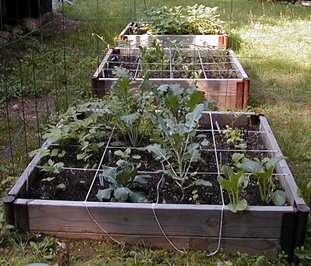I have been meaning to blog about our victory garden since January. Here’s the picture from then.
I haven’t quite gotten the dance down: live life, shoot photos, blog about it.
This is closer to how it looks now, taken on June 7.
Like children, these things grow fast and the gardens look different today. It’s time for a new shot.
Our garden consists of three 4×4 raised beds, divided into one-foot squares, based on Mel Bartholomew’s All New Square Foot Gardening. We also have several pots on the deck with tomatoes, and various herbs planted in pots and garden beds throughout the yard.
We mostly planted items from seeds. Organic seeds. Where seedlings were required, we got help from the Sisters at Bluestone Farm. Most of their seedlings come from their own harvested seeds. The Sisters are indispensable mentors, coaches, and cheerleaders for us.
We don’t imagine we’ll be able to feed ourselves from this garden. It’s not that big, our garden needs more sun (and I’d have to take out a few trees to make that happen), there’s really no protien, and I’m a lousy gardener.
It’s primarily an educational effort. How do things grow? How do you manage pests without chemicals? I planted one square of lentils because I’ve been eating them my entire life and have no idea what they look like growing. I think I planted too many and that they won’t survive because of that.
So far, we’ve harvested the spinach (as it was bolting), some kale, and two broccoli crowns. The broccoli rabe went to seed before it was harvestable. I understand we get a second chance on the spinach and broccoli rabe at the end of the season.

